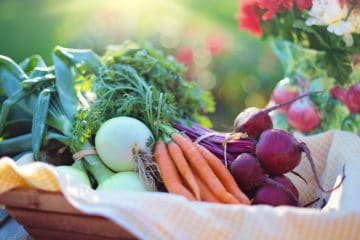Interested in getting a CSA but don’t know where to start? I’ll walk you through the process.
This is the first of three posts on CSAs: I’ll help you decide whether a CSA is a good fit, find options near you, and pick one that you’ll love.
One of my favorite early spring tasks is signing up for our summer CSA. As winter seems to drag on forever and warmer weather arrives in fits and starts, it’s invigorating to think ahead to the pops of flavor and color that young carrots. tender greens, crunchy sugar snaps, and juicy tomatoes will add back into our lives in just a few more months.
We’ve subscribed to a variety of CSAs over the past decade – vegetable, meat, fruit, tiny family farm, large co-op… We’ve switched around not because we weren’t happy (in fact, we’ve been really lucky with our choices so far) but because different CSA options have worked better for us at various times.
And boy, there are a lot of options these days, enough to get overwhelmed!
So let’s take it step by step, starting with a definition:
What is a CSA?
At its core, a CSA is a trust relationship you enter with a farm. You buy a share of the upcoming season’s harvest – providing your farmer with a guaranteed income and market – and in return you receive the promise of several months’ worth of local, seasonal produce.
You can generally expect weekly or biweekly boxes of goodies. Vegetable CSAs are the most common, but all kinds of products are now being offered with this model: fruit, eggs, cheese, meat, malt, honey, bread, pickles, mushrooms, flowers…You name it, there’s probably a CSA for it.
(Click here to learn more about the history of CSAs. They started in Japan in the 1970s!)
But is a CSA right for you? It likely is if…
You like vegetables.
Duh, right? Just remember that you’ll be receiving a new box of produce every single week for several months in a row. You may be surprised at the bounty and variety at the height of the season! That’s all wonderful if you like vegetables, but if you don’t, your compost pile will end up better fed than you.
You like to cook.
Get your vegetable brush and peeler ready! Your carrots will be farm fresh and they’ll look the part – with bits of soil and a bunch of greens at the top (which, by the way, are edible). You’ll be consuming the most local, freshest, and healthiest vegetables around, but they’ll require more prep work than the frozen, canned or already cleaned produce from the supermarket. And when bumper crops of zucchini or turnips pile into your fridge, will you enjoy finding new ways to dispatch them into meals three nights in a row?
You’re flexible with planning your meals.
If you like opening your fridge and conjuring up dishes from whatever you find in there, you’ll probably be much happier with receiving a box of surprise produce than if you’re used to scheduling out a week of meals in advance. (If you’re a meal planner, look for a CSA that sends out a newsletter with crop information for the week, or create your menu once you’ve opened your box.)
You’re open to new food experiences.
CSAs are a great way to try unusual and heirloom varieties. In all likelihood, you’ll encounter crops you’ve never cooked with (or even heard of) before. (Over the years, I’ve gotten to know and like such vegetables as melon cucumbers, black radishes, and tatsoi. I especially loved a fruit CSA that brought me tastes from my childhood in Germany that are hard to find here, such as gooseberries and black currants.)
You want to save money on high-quality food.
There’s a good chance that with a little footwork you’ll find a CSA that meets your needs for less than your usual stores or even the farmers market. When evaluating weekly share costs next to your average grocery bill, remember to compare apples with apples (or beets with beets, as it were): You’ll be eating local, seasonal, and likely organic vegetables, not standard supermarket fare.
You’re willing to make an investment in your future food.
Many CSAs require up-front payment in full, which can be a bit intimidating, since we’re talking about several hundred dollars at once. Sometimes you have the option of trading sweat equity (working on the farm or during delivery) for some of the cost, and some farms accept payment in installments.
You can live with some risk.
In its purest form, a CSA share is not a vegetable subscription. It’s a piece of shared risk. So if a drought hits one year, your vegetable boxes may be a lot lighter than you’d hoped some weeks, or you get loads of some crop you don’t much care for. Other years, you may end up with more salad greens than you know what to do with.
You want to invest in your local economy.
With a CSA, you’ll know exactly where your food comes from and that your payment is going directly to your farmer, providing a guaranteed income and market. More of your money will keep circulating locally.
You want to lighten your impact on the environment.
Your produce has traveled only a short distance from the farm, saving fuel. Many farms grow their crops organically or with other “green” methods.
Does this list describe you?
Then you’re a great candidate for a CSA! Read on to find a CSA near you.
I’ll be writing more in the future on how to get the most out of your CSA, how to buy meat in bulk, and related topics.
Sign up here so you don’t miss a thing!
Photo by jill111/CC0


